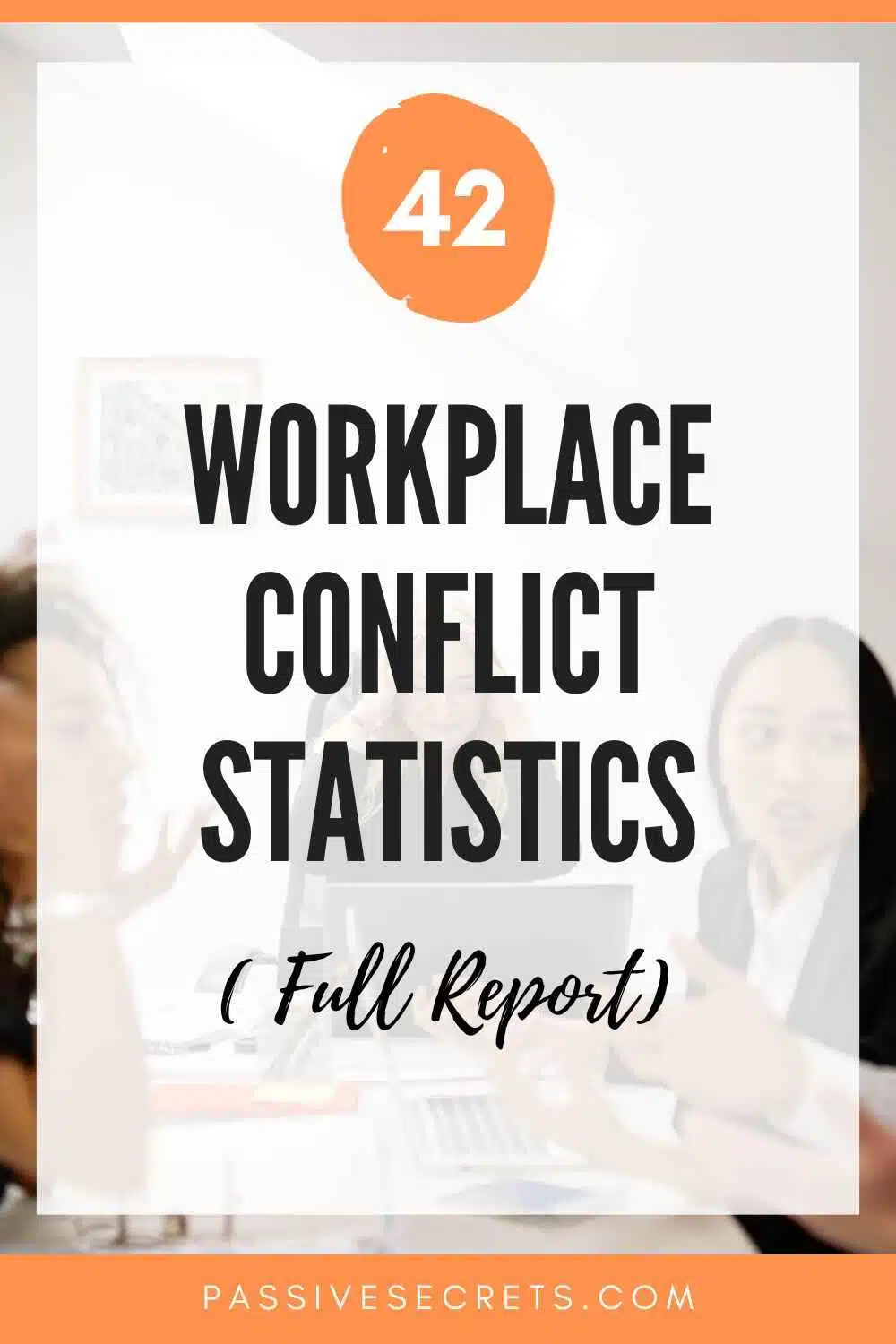![40+ Top Workplace Conflict Statistics You Should Know [2024] Workplace Conflict Statistics Featured Image](https://passivesecrets.com/wp-content/uploads/2023/12/Workplace-Conflict-Statistics-Featured-Image-1024x576.jpeg.webp)
Workplace conflict is a common occurrence in almost every business. The workplace is where we spend most of our time. In fact, statistical data show that the average worker in the U.S. spends up to 1892 hours yearly.
Since we spend a lot of time at work, we are bound to interact with other humans even if we work remotely.
As an employer, line manager, or HR, it is vital to know the latest workplace conflict statistics. These statistics will provide valuable insights into the prevailing challenges and trends at work.
In this article, I selected the latest statistics on workplace conflict to give you more precise insights on tackling workplace conflicts.
What is Workplace Conflict?
Workplace conflicts are disagreements among work colleagues regarding ideas, personalities, work ethics, etc. It’s common for almost every business to experience workplace conflict, especially if the business employs many staff.
Types of Workplace Conflicts
Conflict in the workplace can arise due to different reasons. Hence, the types of workplace conflicts depend on the cause.
1. Task-based Conflicts
These are conflicts caused due to disagreements on tasks. It is common when colleagues are handling interdependent roles. This type of conflict is also known as role conflict, which happens when employees don’t clearly understand their roles, affecting the next employee.
2. Personality-based Conflicts
A company can consist of people with different personalities and walks of life. It is expected to experience a clash of personalities every once in a while. It’s not easy to work with someone with a completely different personality from yours because there will be many disagreements.
3. Work Style Conflicts
As our personalities are different, so are our work styles. In fact, your personality affects your work style. Employees can have different ways they want to accomplish a task, and this can cause conflict.
4. Discrimination
Workplace discrimination is a common occurrence in large companies. Some employees are not given fair treatment and opportunities like others. Sometimes, the discrimination is gender-based, where men are more favored than their female counterparts.
However, discrimination can also be based on other factors like values, lifestyle, race, culture, religion, etc. Discrimination is very serious, and once conflict arises, HR may have to get involved to settle it.
5. Creative Conflict
This is when employees have different viewpoints on handling a project and refuse to agree on a common ground. Unlike other conflict types that are unhealthy and chaotic, creative conflict can be healthy. It challenges employees to put in their A-game in innovation and creativity.
6. Leadership Styles
Aside from employees having conflict, employers/managers/supervisors can also have disagreements. There are different leadership styles, and each one can affect the whole team. The difference in leadership styles can cause conflict in the company.
For example, when two co-founders have different leadership styles, they disagree on how to lead the company. This conflict will affect productivity and, eventually, the company itself.
Revealing Workplace Conflict Statistics
1. Over 85% of employees at all levels experience conflict, one way or another. (source)
2. 57% of employees admit that they have witnessed intense conflict statistics work that resulted in insult or injury. Additionally, up to 27% of employees say they have witnessed conflict in the workplace that caused personal attacks. (source)
3. 10% of employees say the primary reason for workplace conflict is lack of transparency among colleagues. (source)
4. A recent survey in the United Kingdom shows that the total cost of workplace conflict is £28.5 billion. That is the equivalent of more than £1,000 for each employee. (source)
5. According to Acas, over 10 million employees experience conflict at work. As a result of this, more than 50% of them suffer depression, stress, or anxiety. (source)
6. An average of 485,500 employees resign yearly due to workplace conflicts. Additionally, 874,000 employees call in sick due to conflict. (source)
7. 30% of surveyed respondents say that having a work enemy negatively affects their performance. (source)
8. It is believed that there will be an increase in workplace conflict in the subsequent years. This is due to factors including post-COVID tensions around remote work and the increasing demands of a more diverse workforce. (source)
9. Poor communication (47%) and lack of role clarity (42%) are the primary causes of workplace conflict. Other causes include heavy workloads (38%), personality clashes (37%), changes in policies and organizational structures (30%), dysfunctional teams (27%), and so on. The least cause is discriminatory behavior (5%). (source)
![40+ Top Workplace Conflict Statistics You Should Know [2024] Main causes of workplace conflict](https://passivesecrets.com/wp-content/uploads/2023/12/Main-causes-of-workplace-conflict-1.jpg.webp)
10. Also, in the same survey, 52% say workplace conflict gives a mix of positive and negative results. 28% cited that the best positive outcome from workplace conflict is building relationships, collaboration, and cooperation. Another 20% cited that the most common negative outcome is poor relationships and lack of trust and cooperation. (source)
Hence, although conflict can build work relationships, it can also destroy them.
11. In a recent UK survey, 62% of workers believe they have a work enemy set out to annoy them. (source)
12. Also, only 20% of the surveyed UK workers admitted to having close workplace friendships. (source)
13. 48% of workers say they have only one work enemy, while 43% say they have more than one. (source)
14. The survey also shows that work enemies are often the same gender. 65% agreed their work enemy is the same gender. Also, 71% say their work enemy is either the same age as them or older. (source)
15. 60% of workers say they dislike their work enemy because the enemy often bends the truth to make themselves look good and negatively comment on other people’s work performance. (source)
16. 57% say they still think about their work enemy outside work. This proves that your work enemy can be so etched into your skin that they can affect your mood outside work. 30% admit they have lost sleep because of the work enemy. 17% say they have even had a nightmare about an annoying colleague. (source)
17. When it gets intense, 70% of the surveyed workers say they start looking for a new job. (source)
18. 48% of respondents in a recent survey say their supervisor is the one who causes workplace conflict the most. Another 36% believe it is their manager/boss, and 16% blame their coworkers. (source)
![40+ Top Workplace Conflict Statistics You Should Know [2024] Conflict in the Workplace](https://passivesecrets.com/wp-content/uploads/2023/12/Conflict-in-the-Workplace-01-1024x466.jpeg.webp)
19. 51% of respondents in the survey say they have wanted to quit their jobs due to conflict. However, only 41% say they followed through. (source)
20. The top 3 common emotions that lead to tension in the workplace are stress (45%), anger (44%), and frustration (38%). (source)
21. According to surveyed employees (50%) and managers (45%), stress is the primary emotional cause of workplace conflict. (source)
22. 68% of men and 62% of women in a survey admitted they have been involved in workplace romance that lead to conflict. (source)
Conflict Management Statistics
23. According to 44% of surveyed workers, the line manager or supervisor is the one responsible for managing conflict in the workplace. (source)
24. Managers spend an average of 4 hours every week dealing with conflict. (source)
25. 49.2% of surveyed workers agree they manage conflict adequately well. 6.5% say they handle it very well, while 34.4% prefer they do so quite well. (source)
![40+ Top Workplace Conflict Statistics You Should Know [2024] Workplace conflict statistics](https://passivesecrets.com/wp-content/uploads/2023/12/Workplace-conflict-statistics.jpg.webp)
26. 55% of extroverts agree that they manage conflict well, while only 42% of introverts agree they do the same. (source)
27. 75% of employees believe their managers or supervisors could manage conflicts more effectively. (source)
28. Only 44% of employees who have experienced conflict report that the conflict was fully resolved. (source)
29. 55% of surveyed workers say they occasionally deal with conflict at work. However, about 36% deal with conflict often, very often, and all the time. (source)
30. Also, 24% of company employees think challenging issues such as bullying and harassment are swept under the carpet in their organization instead of being addressed and resolved. (source)
31. Up to 20% of employees agree that their team/department/company is not inclusive. This means their teammates or colleagues often reject others for being different. (source)
32. 31% of surveyed employees who have experienced conflict admitted that the person they reported the issue to didn’t take it seriously. (source)
33. Only 40% of managers say that their company provides training in people management skills to support them in their management role. (source)
34. However, employees aren’t still satisfied because 32% of surveyed employees say that the people manager they reported the conflict to only made it worse. (source)
35. Employees deal with conflict differently. 1 in 5 employees say they often take no action in disputes they are involved in. However, about 25% of other employees discuss the issue with the other party. But, over 50% say they discuss the matter with their manager or HR. (source)
36. A whooping 98% of surveyed respondents agree that conflict management is a crucial leadership or management skill. In the survey, 72% of the respondents agreed that conflict handling is a critical skill for leaders and managers. 26% agreed that it is very important. (source)
37. 52% of employees believe there is no difference in how men and women handle conflict. (source)
38. 23% of respondents in a UK survey say things got better for them at work, even when they finally talked to their work enemy. (source)
39. 88% of employees who have experienced workplace conflict say HR got involved. (source)
40. Gen-Z workers (86%) are most likely to involve HR in their conflict. (source)
41. About 79% of surveyed workers say they were required to take a workplace conflict class, which they found very helpful. (source)
42. 55.7% of workers prefer to restore harmony when resolving conflict. (source)
Conclusion
The workplace conflict statistics in this article reveal how much conflict can affect employees’ performance. Neglected conflict can develop into more significant problems.
With remote work, diverse teams, and shifting societal norms, the sources of workplace conflict are as diverse as the workforce itself.
Knowing these statistics will help you understand how to handle conflict when it threatens to arise.
![40+ Top Workplace Conflict Statistics You Should Know [2024] Workplace Conflict Statistics PassiveSecrets](https://passivesecrets.com/wp-content/uploads/2023/12/Workplace-Conflict-Statistics-PassiveSecrets-683x1024.jpeg.webp)
Recent Posts:
- 47+ Important 4-day Work Week Statistics You Must Know In 2024
- 73 Revealing Workplace Distraction Statistics [2024]
- 50+ Latest Life Coaching Statistics And Huge Trends In 2024
- 36 Interesting Social Worker Burnout Statistics for 2024
- 39 Best Emotional Intelligence Statistics To Know
- 41+ Important Communication Skills Statistics & Trends
- 51+ Teamwork & Workplace Collaboration Statistics To Boost Your Employee Performance
- 51+ Important Podcast Advertising Statistics To Know
- 47+ Multi-Level And Network Marketing Statistics You Need To Know
- 81+ Sales Funnel Statistics To Help Improve Conversion Rates
- 15 Crucial Body Language Statistics To Know
- 53 Most Important Workplace Communication Statistics
- 100 Top Digital Marketing Vs Traditional Marketing Statistics
- 50 Trade Show Statistics and Trends to Boost Your Business
- 41+ Multichannel Marketing Statistics and Trends
- 68 Incredible Performance Management Statistics & Trends

